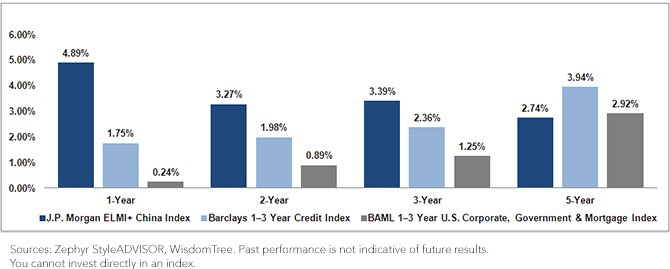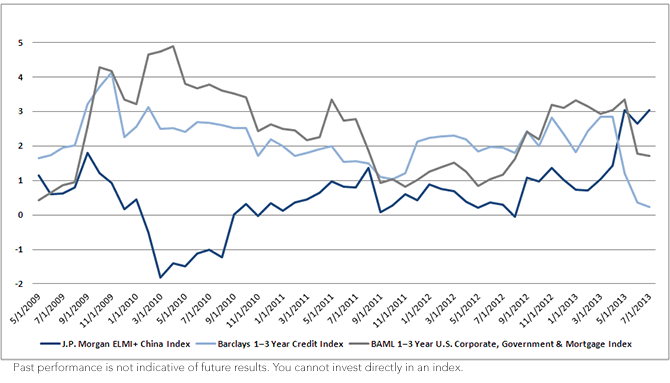Chinese Yuan: A Potential Alternative for a Rising Rate Environment


 For definitions of indexes in the chart, please visit our Glossary.
When compared to other foreign currencies, the Chinese yuan has been broadly stable despite the sometimes volatile moves in emerging markets. This is largely a product of the “managed band” that Chinese policy makers currently impose on the yuan. Although the band prevents large upside surprises, the downside is also capped, which could be attractive to investors seeking to limit volatility. Additionally, investors have also benefited from the higher interest rates available from short-term investments in the yuan, boosting total returns relative to spot. When taking into account the yuan’s historic volatility (approximately 2.4%), investors in China’s currency have achieved higher risk-adjusted returns than virtually all fixed income or currency investments so far in 2013.2 In the graph below, we track the rolling 12-month Sharpe ratio of the J.P. Morgan ELMI+ China Index and two short-term fixed income indexes representing the fastest growing sector of fixed income in 2013. As volatility has increased in U.S. interest rates and returns have waned, the Sharpe ratios of U.S. fixed income have tended to trend downward. By comparison, consistent volatility and positive performance have contributed to the yuan’s current upswing.
Rolling 12-Month Sharpe Ratio: June 1, 2008 - July 21, 2013
For definitions of indexes in the chart, please visit our Glossary.
When compared to other foreign currencies, the Chinese yuan has been broadly stable despite the sometimes volatile moves in emerging markets. This is largely a product of the “managed band” that Chinese policy makers currently impose on the yuan. Although the band prevents large upside surprises, the downside is also capped, which could be attractive to investors seeking to limit volatility. Additionally, investors have also benefited from the higher interest rates available from short-term investments in the yuan, boosting total returns relative to spot. When taking into account the yuan’s historic volatility (approximately 2.4%), investors in China’s currency have achieved higher risk-adjusted returns than virtually all fixed income or currency investments so far in 2013.2 In the graph below, we track the rolling 12-month Sharpe ratio of the J.P. Morgan ELMI+ China Index and two short-term fixed income indexes representing the fastest growing sector of fixed income in 2013. As volatility has increased in U.S. interest rates and returns have waned, the Sharpe ratios of U.S. fixed income have tended to trend downward. By comparison, consistent volatility and positive performance have contributed to the yuan’s current upswing.
Rolling 12-Month Sharpe Ratio: June 1, 2008 - July 21, 2013
 For definitions of indexes in the chart, please visit our Glossary.
But risk and return tell only part of the story. The Chinese yuan has had only modest correlation to the S&P 500 Index and the Barclays U.S. Aggregate Bond Index (0.11 and 0.06, respectively) over the last five years. Given the uncertainty related to shifts in Federal Reserve (Fed) policy, a non-correlated asset could add valuable diversification to investor portfolios.3
What’s Driving the Yuan’s Performance?
Interestingly, as China has continued down the path of currency internationalization, the increasing means of access have created new opportunities for income in Chinese yuan-denominated assets. So far in 2013, more than one-third of the J.P. Morgan ELMI+ China Index’s performance has been driven by returns from interest rates in Hong Kong and China.4 The remaining performance can be attributed to a broadly stronger yuan. In our view, we can best explain this phenomenon as part of the Chinese rebalancing that is currently being overseen by Premier Li Keqiang.
Outlook
Chinese policy makers have historically proven to be extremely pragmatic. If the best policy for U.S. investors has been to not “fight the Fed,” we believe this maxim also applies to the Politburo Standing Committee in China. During this most recent period of global rebalancing, the Chinese government will continue to make adjustments that affect the Chinese economy. So far in 2013, it seems that an appreciating yuan has been in China’s best interest. As we stated above, a gradual, low-volatility rebalancing seems to be the most logical course of action. Similar to what investors experienced during the Asian financial crisis in the late ’90s, Chinese policy makers appear reluctant to devalue the yuan in the face of market stress. In fact, since the Chinese yuan was allowed to “float” in 2005, it has yet to depreciate against the U.S. dollar in a calendar year.
1Source: WisdomTree, Bloomberg; August 23, 2013.
2Source: Bloomberg; 2013.
3Source: Zephyr StyleADVISOR, July 31, 2013.
4Source: J.P. Morgan, July 31, 2013.
For definitions of indexes in the chart, please visit our Glossary.
But risk and return tell only part of the story. The Chinese yuan has had only modest correlation to the S&P 500 Index and the Barclays U.S. Aggregate Bond Index (0.11 and 0.06, respectively) over the last five years. Given the uncertainty related to shifts in Federal Reserve (Fed) policy, a non-correlated asset could add valuable diversification to investor portfolios.3
What’s Driving the Yuan’s Performance?
Interestingly, as China has continued down the path of currency internationalization, the increasing means of access have created new opportunities for income in Chinese yuan-denominated assets. So far in 2013, more than one-third of the J.P. Morgan ELMI+ China Index’s performance has been driven by returns from interest rates in Hong Kong and China.4 The remaining performance can be attributed to a broadly stronger yuan. In our view, we can best explain this phenomenon as part of the Chinese rebalancing that is currently being overseen by Premier Li Keqiang.
Outlook
Chinese policy makers have historically proven to be extremely pragmatic. If the best policy for U.S. investors has been to not “fight the Fed,” we believe this maxim also applies to the Politburo Standing Committee in China. During this most recent period of global rebalancing, the Chinese government will continue to make adjustments that affect the Chinese economy. So far in 2013, it seems that an appreciating yuan has been in China’s best interest. As we stated above, a gradual, low-volatility rebalancing seems to be the most logical course of action. Similar to what investors experienced during the Asian financial crisis in the late ’90s, Chinese policy makers appear reluctant to devalue the yuan in the face of market stress. In fact, since the Chinese yuan was allowed to “float” in 2005, it has yet to depreciate against the U.S. dollar in a calendar year.
1Source: WisdomTree, Bloomberg; August 23, 2013.
2Source: Bloomberg; 2013.
3Source: Zephyr StyleADVISOR, July 31, 2013.
4Source: J.P. Morgan, July 31, 2013.Important Risks Related to this Article
Diversification does not eliminate the risk of experiencing investment loses. Investments in currency involve additional special risks, such as credit risk and interest rate fluctuations. Investments focused in China are increasing the impact of events and developments associated with the region, which can adversely affect performance.

Rick Harper serves as the Chief Investment Officer, Fixed Income and Model Portfolios at WisdomTree Asset Management, where he oversees the firm’s suite of fixed income and currency exchange-traded funds. He is also a voting member of the WisdomTree Model Portfolio Investment Committee and takes a leading role in the management and oversight of the fixed income model allocations. He plays an active role in risk management and oversight within the firm.
Rick has over 29 years investment experience in strategy and portfolio management positions at prominent investment firms. Prior to joining WisdomTree in 2007, Rick held senior level strategist roles with RBC Dain Rauscher, Bank One Capital Markets, ETF Advisors, and Nuveen Investments. At ETF Advisors, he was the portfolio manager and developer of some of the first fixed income exchange-traded funds. His research has been featured in leading periodicals including the Journal of Portfolio Management and the Journal of Indexes. He graduated from Emory University and earned his MBA at Indiana University.

